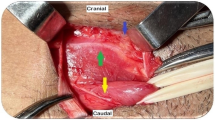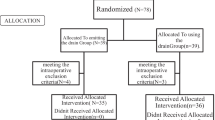Abstract
The aim of this study was to compare the operative parameters and complication rates between the umbilical (UMB) and right upper quadrant (RUQ) skin incisions for Ramstedt’s pyloromyotomy for the treatment of infantile hypertrophic pyloric stenosis (IHPS). PubMed, EMBASE, Web of Science and Scopus databases were systematically searched. The studies where any one of the main outcomes of interest, i.e., operative time, wound infection rate, mucosal perforation rate were reported were eligible for inclusion. The statistical analysis was performed using a random-effects model. The methodological quality of the studies was assessed utilizing the Newcastle–Ottawa Scale. Fifteen studies comprising 2964 infants were included. As compared to the UMB group, the RUQ group showed a significantly lower mean operative time (p = 0.0004), wound infection rate (p < 0.0001) and mucosal perforation rate (p = 0.02). Although UMB incision produces an almost undetectable scar, this approach results in significantly more complications. Therefore, the risks and benefits must be weighed and discussed with the caregivers in deciding the surgical approach in patients with IHPS. However, due to a poor methodological quality of nine out of fifteen studies, further studies need to be conducted for an optimal comparison between the two groups.








Similar content being viewed by others

Data availability
No datasets were generated or analysed during the current study.
References
Kapoor R, Kancherla V, Cao Y et al (2019) Prevalence and descriptive epidemiology of infantile hypertrophic pyloric stenosis in the United States: a multistate, population-based retrospective study, 1999–2010. Birth Defects Res 111:159–169. https://doi.org/10.1002/bdr2.1439
Leong M-M, Chen SC-C, Hsieh C-S et al (2011) Epidemiological features of infantile hypertrophic pyloric stenosis in Taiwanese children: a nation-wide analysis of cases during 1997–2007. PLoS ONE 6:e19404. https://doi.org/10.1371/journal.pone.0019404
Spicer RD (1982) Infantile hypertrophic pyloric stenosis: a review. Br J Surg 69:128–135. https://doi.org/10.1002/bjs.1800690304
Hussain M (2008) Sonographic diagnosis of infantile hypertrophic pyloric stenosis- use of simultaneous grey-scale & colour Doppler examination. Int J Health Sci 2:134–140
Meissner PE, Engelmann G, Troeger J et al (2006) Conservative treatment of infantile hypertrophic pyloric stenosis with intravenous atropine sulfate does not replace pyloromyotomy. Pediatr Surg Int 22:1021–1024. https://doi.org/10.1007/s00383-006-1751-3
Mazurak M, Patkowski D (2021) A history of the surgical correction of pyloric stenosis. J Pediatr Surg 56:1904–1907. https://doi.org/10.1016/j.jpedsurg.2021.05.009
Bensard DD (2009) Hypertrophic pyloric stenosis. In: Harken AH, Moore EE (eds) Abernathy’s Surgical Secrets, 6th edn. Mosby, Philadelphia, pp 415–416
Levi B, Mychaliska GB (2010) Operative management of pyloric stenosis: pyloromyotomy. In: Minter RM, Doherty GM (eds) Current Procedures: Surgery, 1st edn. The McGraw-Hill Companies, New York, NY, pp 366–370
Tan KC, Bianchi A (1986) Circumumbilical incision for pyloromyotomy. Br J Surg 73:399. https://doi.org/10.1002/bjs.1800730529
Hernández-Vaquero ID, Palacios MEC, Rodríguez RF et al (2023) Analysis of esthetic assessment scales in two surgical approaches for hypertrophic pyloric stenosis. Cirugia Pediatr Organo Of Soc Espanola Cirugia Pediatr 36:12–16
Wells G, Shea B, O’Connell D, et al (2000) The Newcastle–Ottawa scale (NOS) for assessing the quality of non-randomized studies in meta-analysis. Ottawa Hospital Research Institute. https://www.ohri.ca/programs/clinical_epidemiology/oxford.asp. Accessed 17 Feb 2024
Peyvasteh M, Askarpour S, Khoshkhabar M, Javaherizadeh H (2020) Pyloromyotomy in hypertrophic pyloric stenosis: a comparative study between supraumbilical curved skin incision and standard (right upper quadrant) skin incision: study in a resource limited setting. Open Access Surg 13:79–83. https://doi.org/10.2147/OAS.S262825
Habib M, Raza R, Ahmed M et al (2023) A comparative study of Bianchi versus right upper transverse approach in infantile hypertrophic pyloric stenosis. J Surg Protoc Res Methodol. https://doi.org/10.1093/jsprm/snac025
Meyer T, Jud S, Höcht B (2007) Therapy of infantile hypetrophic pylorus stenosis. Comparison of two different surgical skin incisions for pyloromyotomy by Weber-Ramstedt. Padiatrische Prax 70:453–459
Kuroiwa M, Suzuki N, Takahashi A et al (2001) Circumumbilical incision for pyloromyotomy in hypertrophic pyloric stenosis. Kitakanto Med J 51:295–299. https://doi.org/10.2974/kmj.51.295
Carrera N, Cerdá JA, Cañizo A et al (2010) Hypertrophic pyloric stenosis: comparison between transversal and supraumbilical incision. Cirugia Pediatr Organo Of Soc Espanola Cirugia Pediatr 23:77–81
Fitzgerald PG, Lau GY, Langer JC, Cameron GS (1990) Umbilical fold incision for pyloromyotomy. J Pediatr Surg 25:1117–1118. https://doi.org/10.1016/0022-3468(90)90743-s
Huddart SN, Bianchi A, Kumar V, Gough DCS (1993) Ramstedt’s pyloromyotomy: circumumbilical versus transverse approach. Pediatr Surg Int 8:395–396. https://doi.org/10.1007/BF00176726
Poli-Merol ML, Francois S, Lefebvre F et al (1996) Interest of umbilical fold incision for pyloromyotomy. Eur J Pediatr Surg Off J Austrian Assoc Pediatr Surg Al Z Kinderchir 6:13–14. https://doi.org/10.1055/s-2008-1066458
Podevin G, Missirlu A, Branchereau S et al (1997) Umbilical incision for pyloromyotomy. Eur J Pediatr Surg Off J Austrian Assoc Pediatr Surg Al Z Kinderchir 7:8–10. https://doi.org/10.1055/s-2008-1071039
Leinwand MJ, Shaul DB, Anderson KD (1999) The umbilical fold approach to pyloromyotomy: is it a safe alternative to the right upper-quadrant approach? J Am Coll Surg 189:362–367. https://doi.org/10.1016/S1072-7515(99)00136-2
Blümer RME, Hessel NS, van Baren R et al (2004) Comparison between umbilical and transverse right upper abdominal incision for pyloromyotomy. J Pediatr Surg 39:1091–1093. https://doi.org/10.1016/j.jpedsurg.2004.03.063
Kim SS, Lau ST, Lee SL et al (2005) Pyloromyotomy: a comparison of laparoscopic, circumumbilical, and right upper quadrant operative techniques. J Am Coll Surg 201:66–70. https://doi.org/10.1016/j.jamcollsurg.2005.03.020
Aldridge RD, MacKinlay GA, Aldridge RB (2007) Choice of incision: the experience and evolution of surgical management of infantile hypertrophic pyloric stenosis. J Laparoendosc Adv Surg Tech A 17:131–136. https://doi.org/10.1089/lap.2006.0525
Taqi E, Boutros J, Emil S et al (2007) Evaluation of surgical approaches to pyloromyotomy: a single-center experience. J Pediatr Surg 42:865–868. https://doi.org/10.1016/j.jpedsurg.2006.12.051
Perger L, Fuchs JR, Komidar L, Mooney DP (2009) Impact of surgical approach on outcome in 622 consecutive pyloromyotomies at a pediatric teaching institution. J Pediatr Surg 44:2119–2125. https://doi.org/10.1016/j.jpedsurg.2009.02.067
Tander B, Shanti CM, Klein MD (2009) Access to the hypertrophic pylorus: does it make a difference to the patient? Eur J Pediatr Surg Off J Austrian Assoc Pediatr Surg Al Z Kinderchir 19:14–16. https://doi.org/10.1055/s-2008-1039006
Zakaria OM (2016) Non-laparoscopic minimal surgical approach to pyloromyotomy: an experience from a challenged resource setting. Afr J Paediatr Surg AJPS 13:189–192. https://doi.org/10.4103/0189-6725.194672
Hulka F, Harrison MW, Campbell TJ, Campbell JR (1997) Complications of pyloromyotomy for infantile hypertrophic pyloric stenosis. Am J Surg 173:450–452. https://doi.org/10.1016/S0002-9610(97)00075-5
Aiolfi A, Asti E, Costa E et al (2018) Umbilical microbiome and laparoscopic surgery: a descriptive clinical study. J Laparoendosc Adv Surg Tech A 28:1196–1201. https://doi.org/10.1089/lap.2018.0140
Besson R, Sfeir R, Salakos C, Debeugny P (1997) Congenital pyloric stenosis: a modified umbilical incision for pyloromyotomy. Pediatr Surg Int 12:224–225
Hope WW, Tuma F (2024) Incisional Hernia. In: StatPearls. https://www.ncbi.nlm.nih.gov/books/NBK435995/. Accessed 23 Feb 2024
Funding
No funding was received for this study.
Author information
Authors and Affiliations
Contributions
H.K.: systematic literature search, Data Extraction, Formal Analysis, Writing—original draft; N.K.: data Extraction, Formal analysis, Writing—original draft; D.K.: methodological quality assessment, Writing—review and editing, Supervision; A.V.: methodological quality assessment, Writing—review and editing; S.An.: conceptualization, Systematic search, Formal analysis; S.Ag.: supervision, Validation, Writing—review and editing.
Corresponding author
Ethics declarations
Conflict of interest
The authors report no competing interests in this article.
Additional information
Publisher's Note
Springer Nature remains neutral with regard to jurisdictional claims in published maps and institutional affiliations.
Supplementary Information
Below is the link to the electronic supplementary material.
Rights and permissions
Springer Nature or its licensor (e.g. a society or other partner) holds exclusive rights to this article under a publishing agreement with the author(s) or other rightsholder(s); author self-archiving of the accepted manuscript version of this article is solely governed by the terms of such publishing agreement and applicable law.
About this article
Cite this article
Khandelia, H., Krishnan, N., Kainth, D. et al. Comparison between umbilical and right upper transverse abdominal incisions for pyloromyotomy: a systematic review and meta-analysis. Pediatr Surg Int 40, 163 (2024). https://doi.org/10.1007/s00383-024-05747-4
Accepted:
Published:
DOI: https://doi.org/10.1007/s00383-024-05747-4



